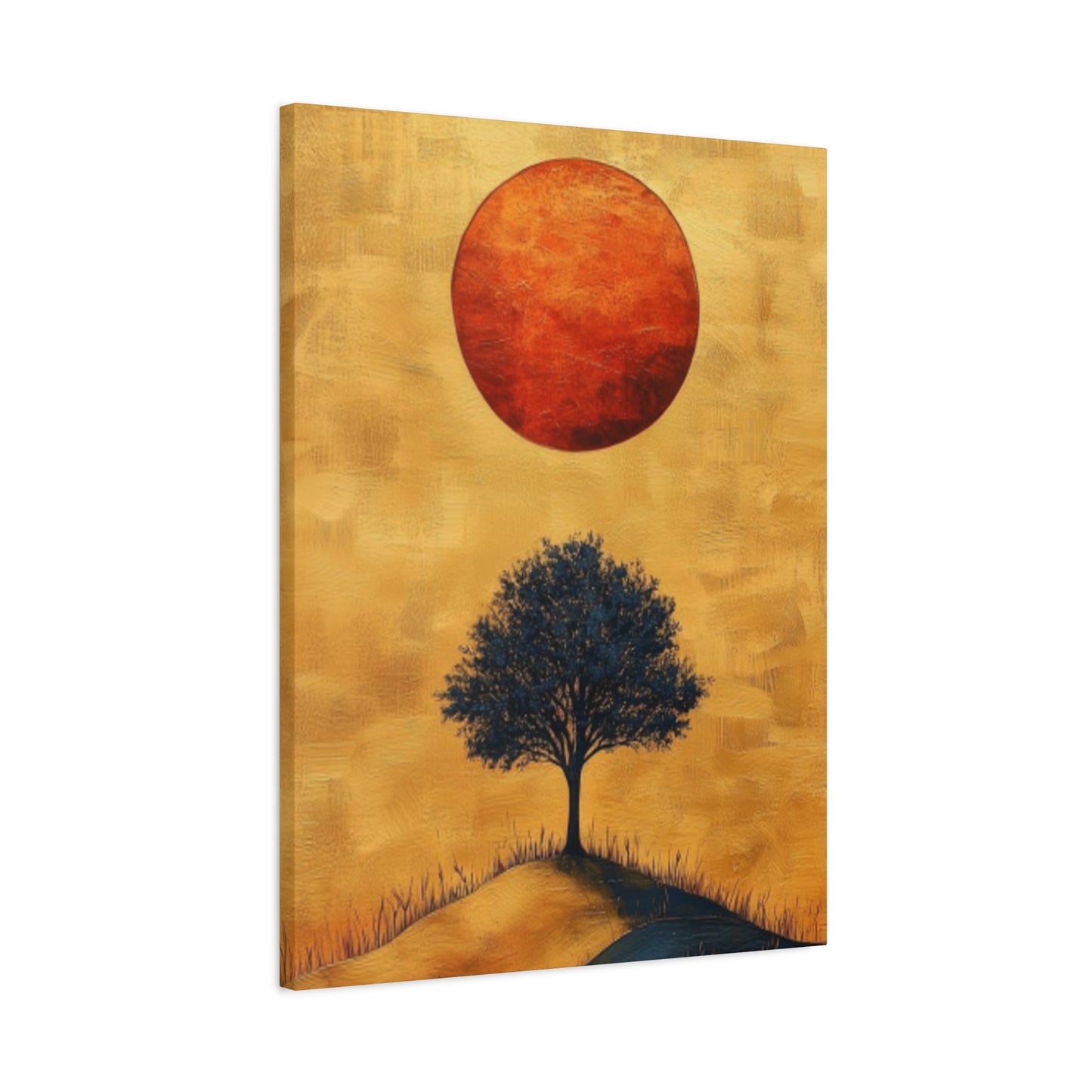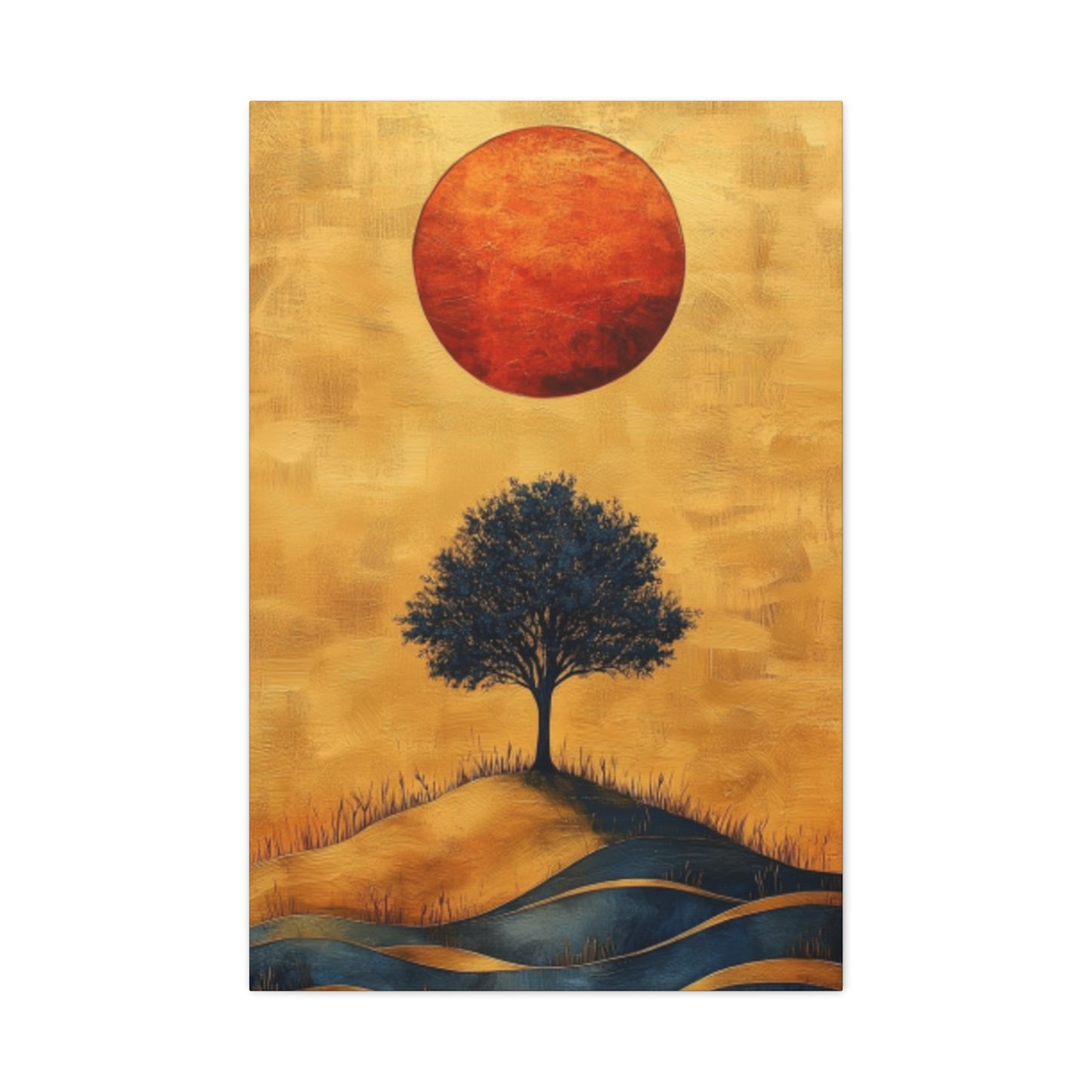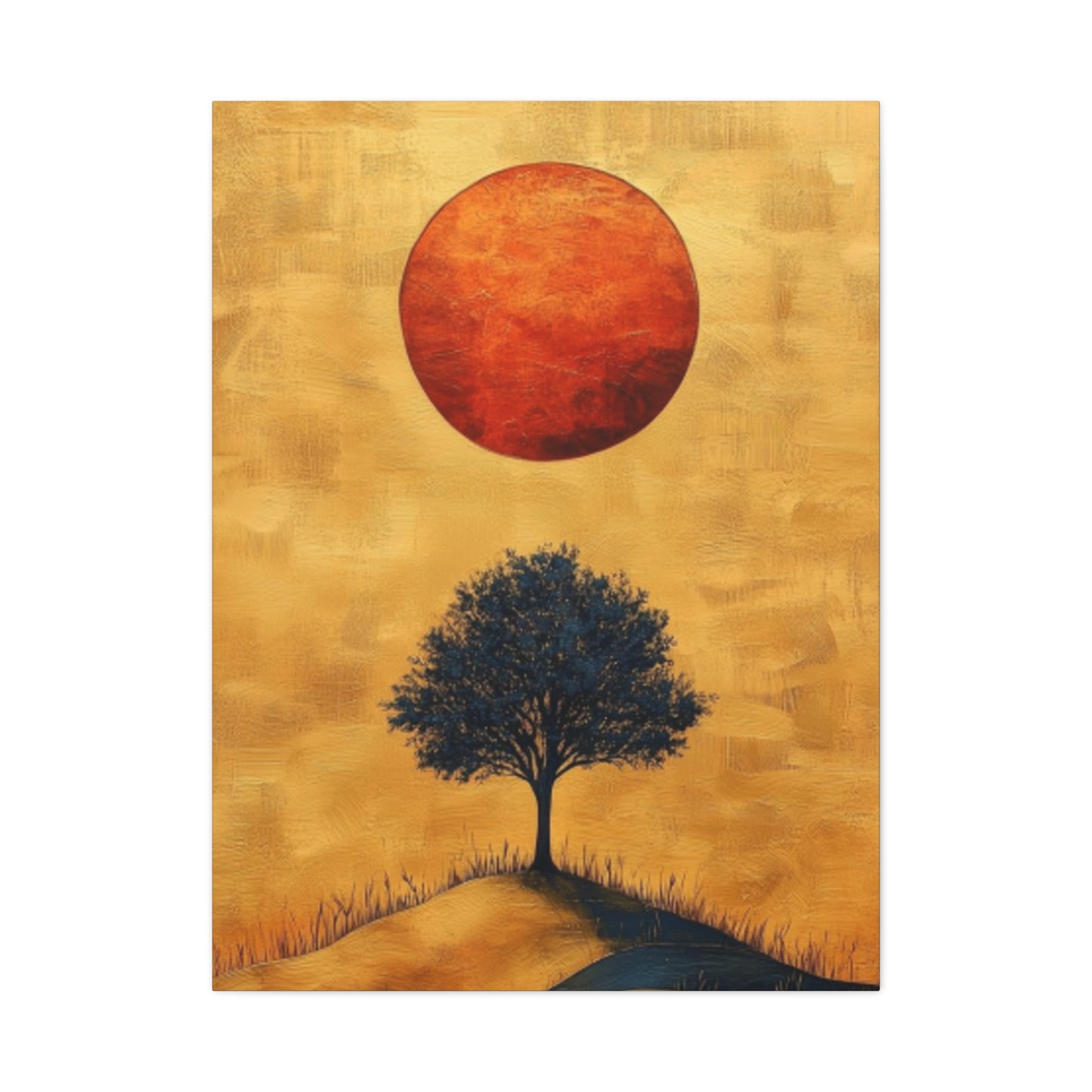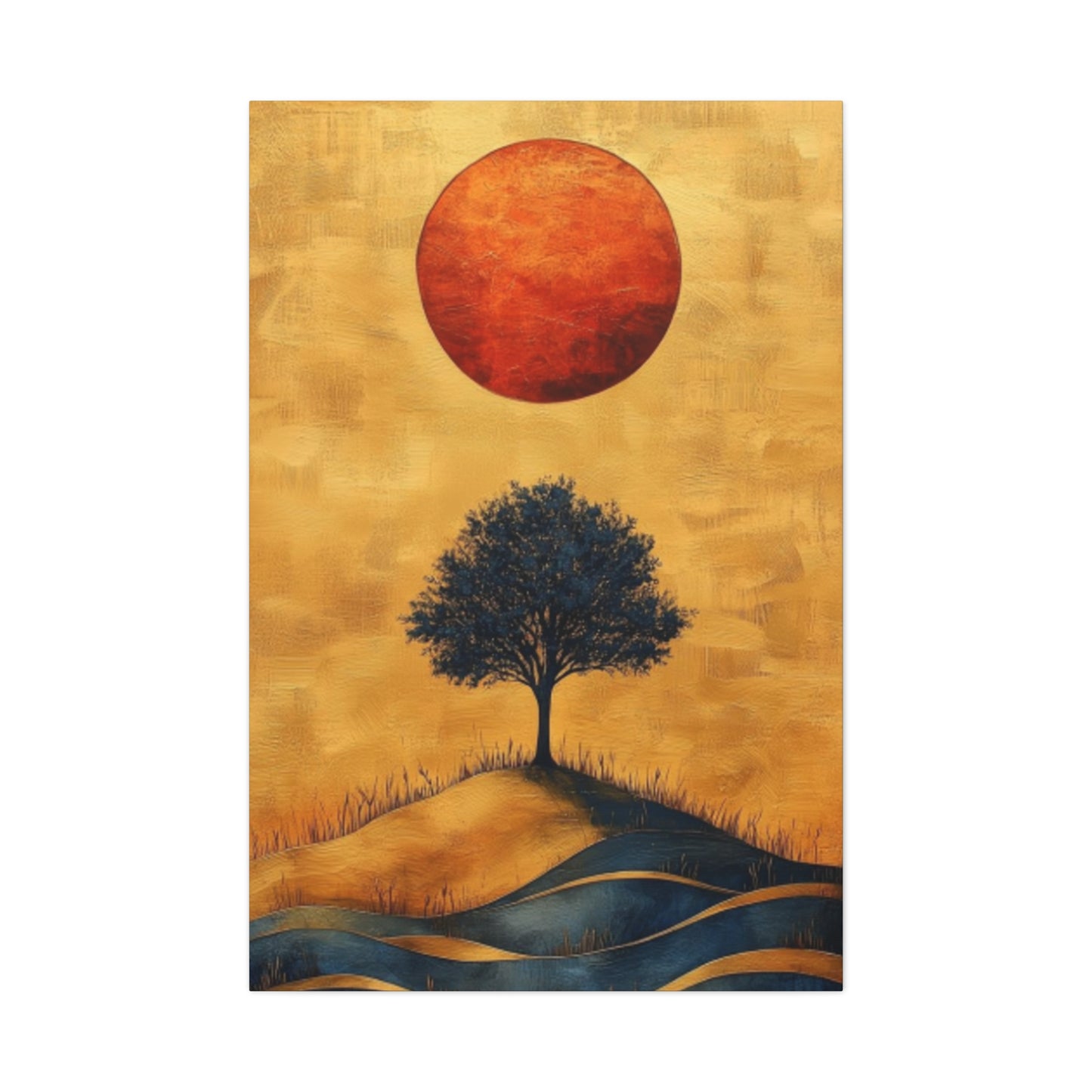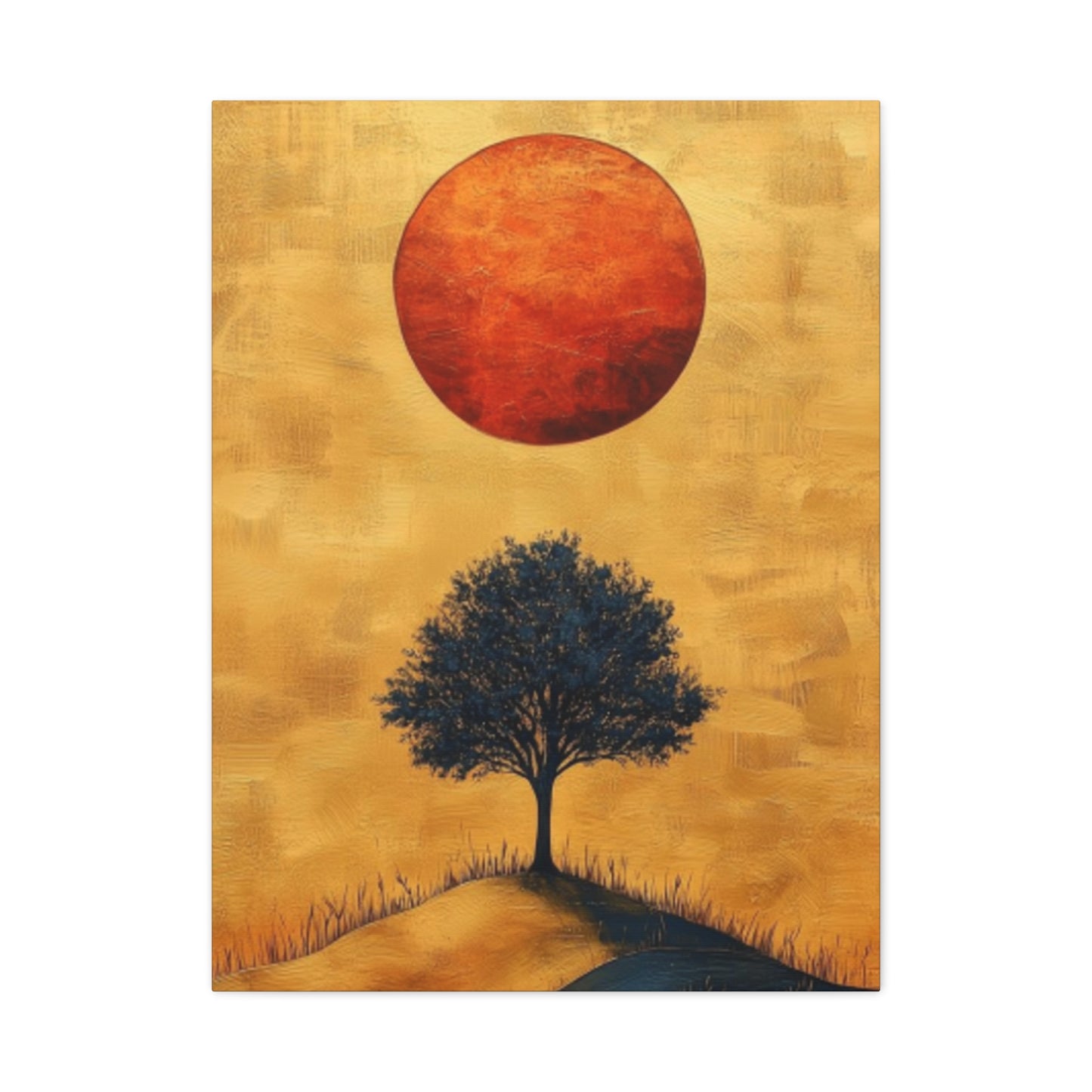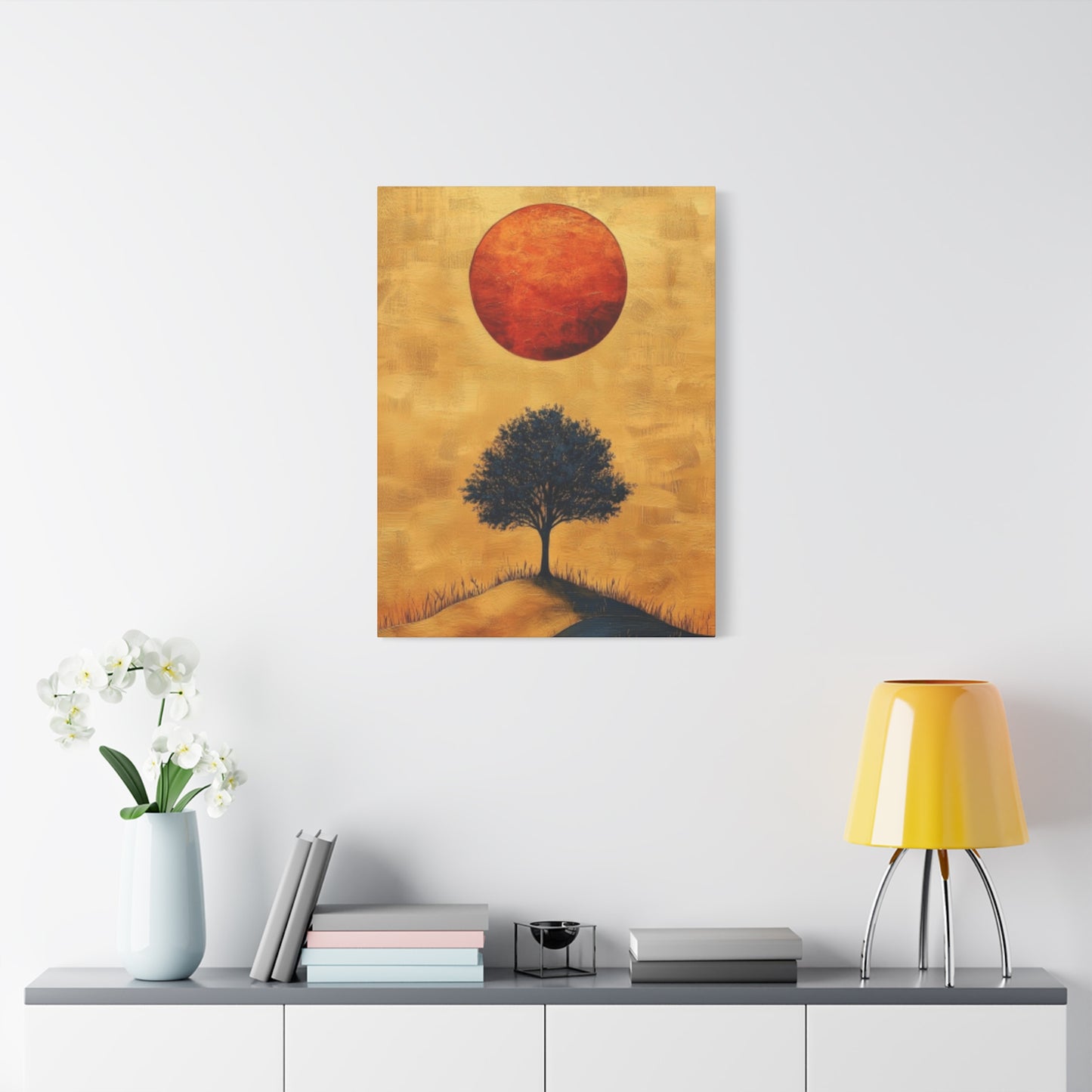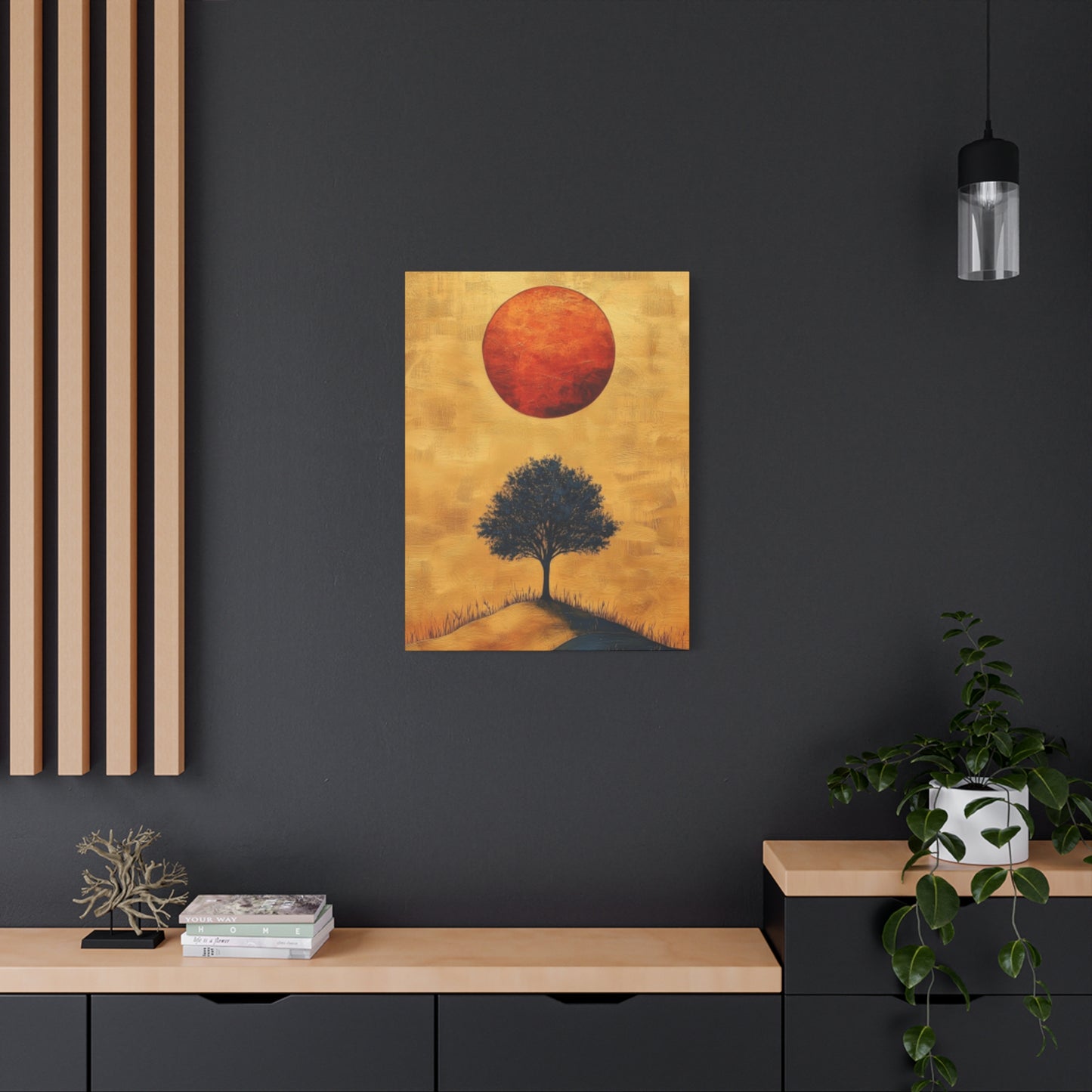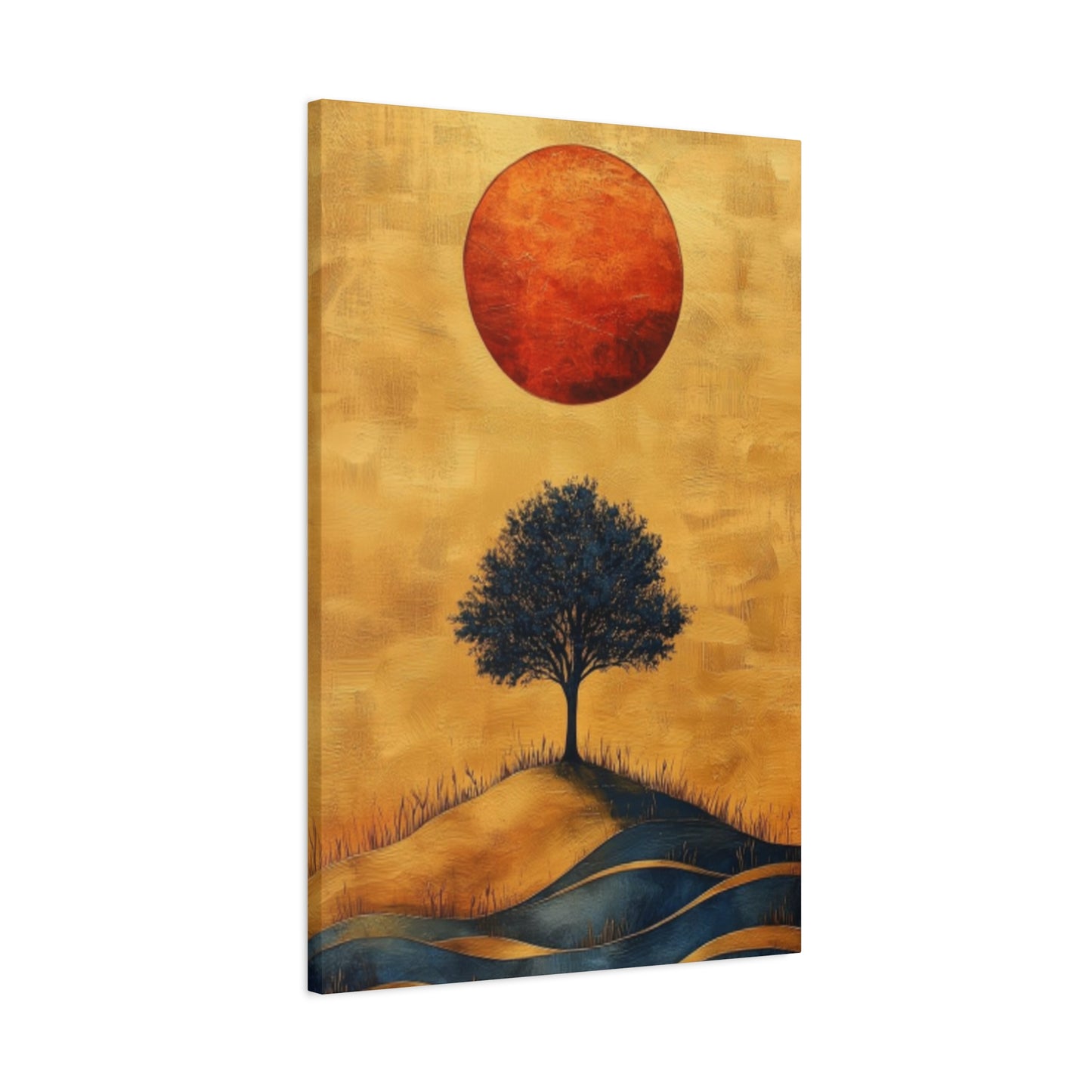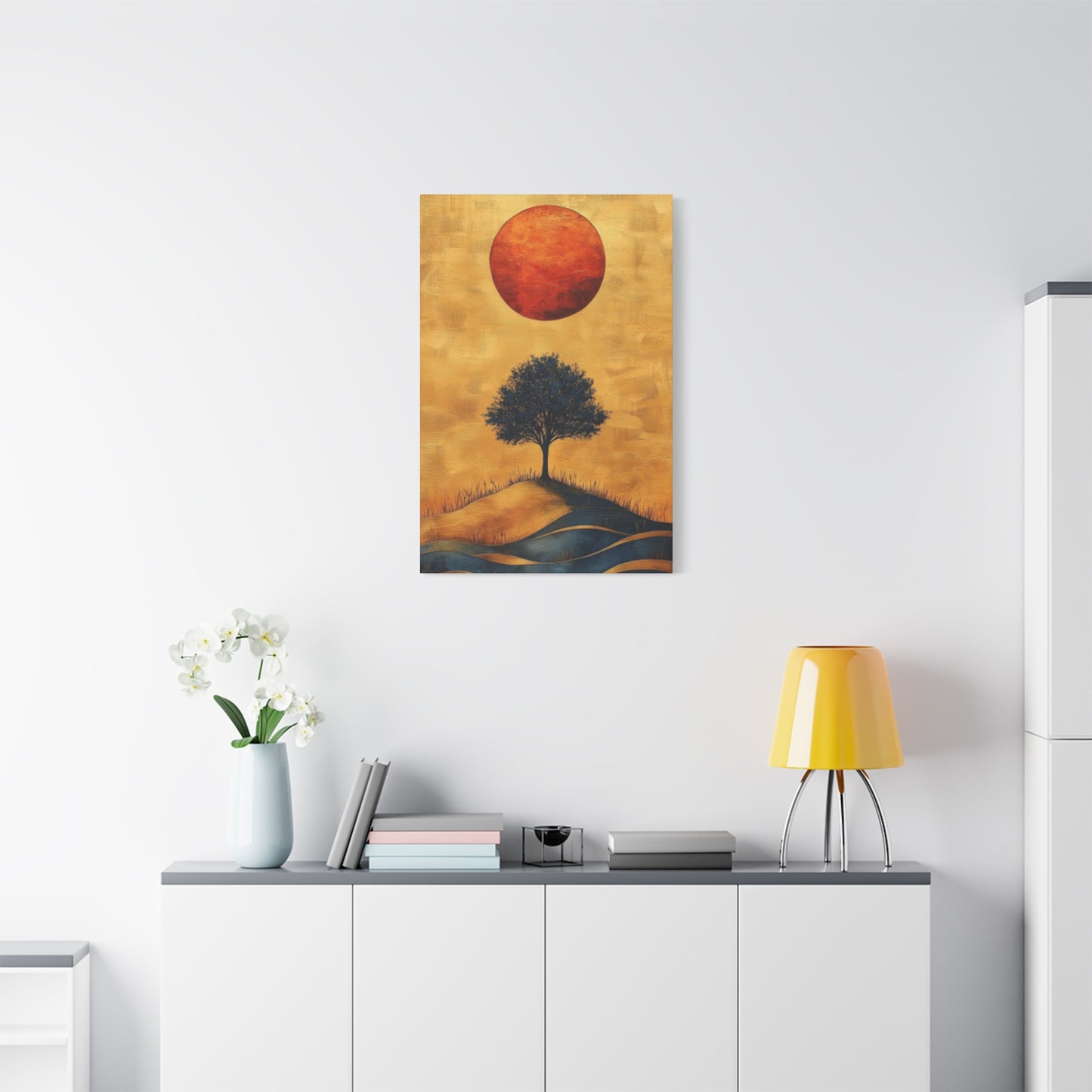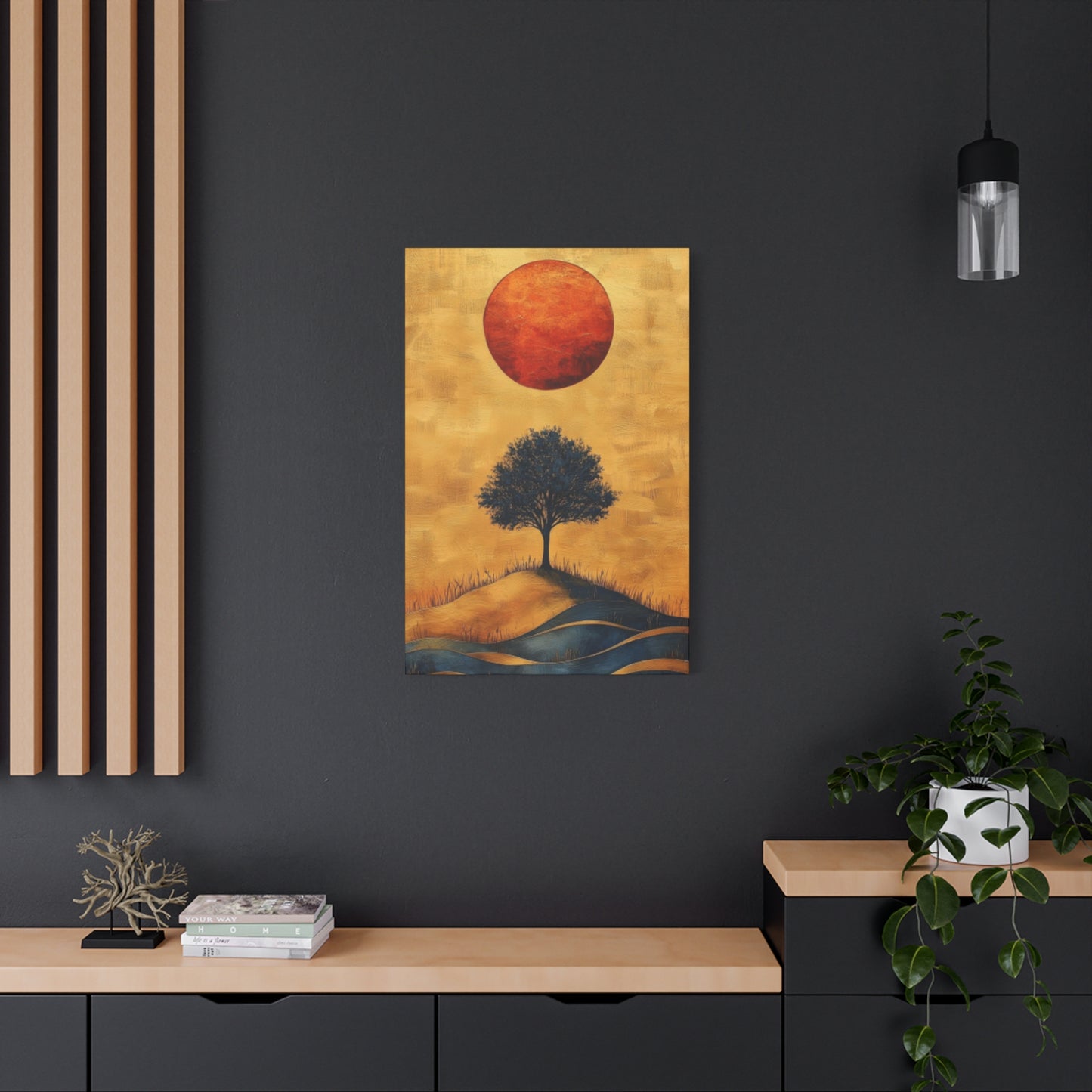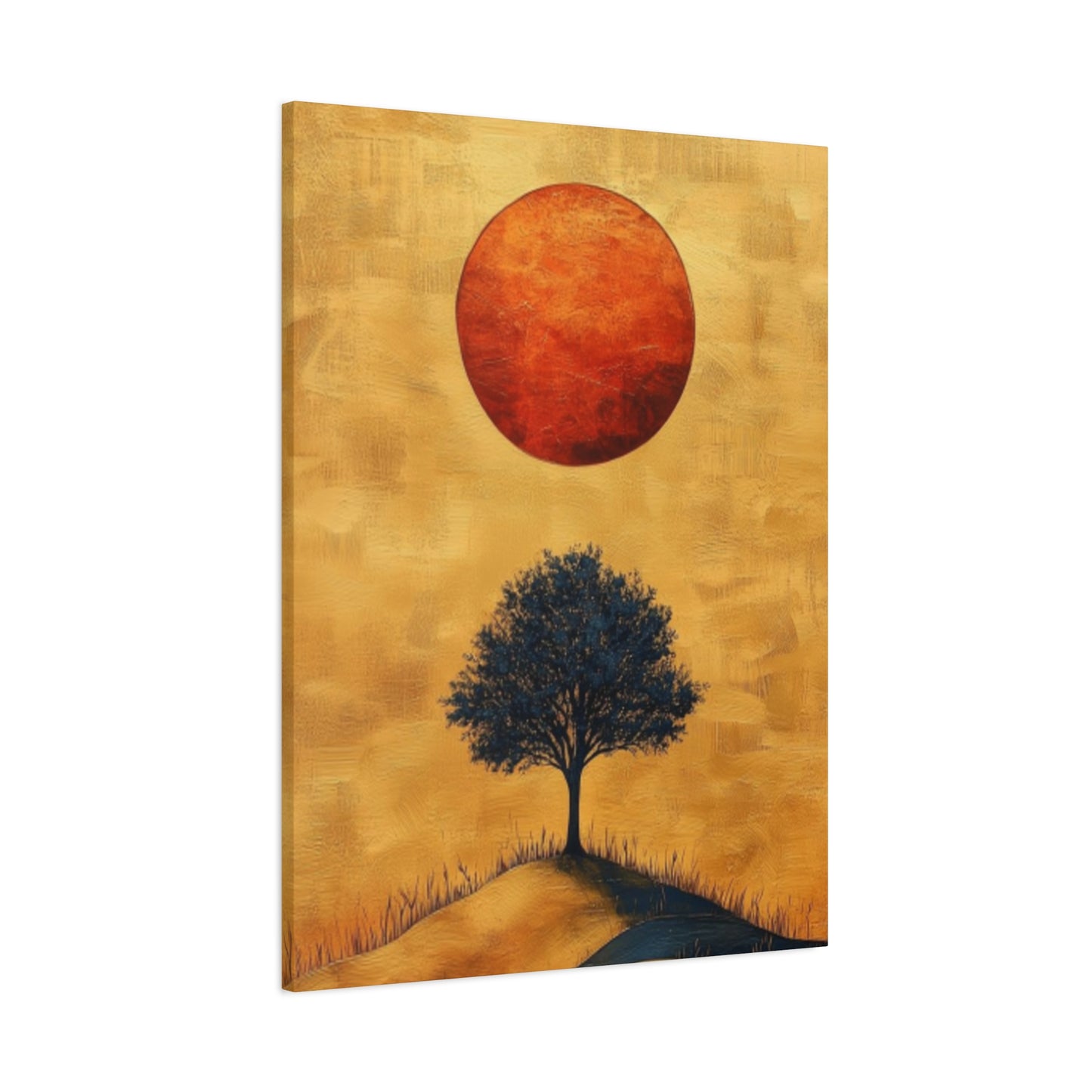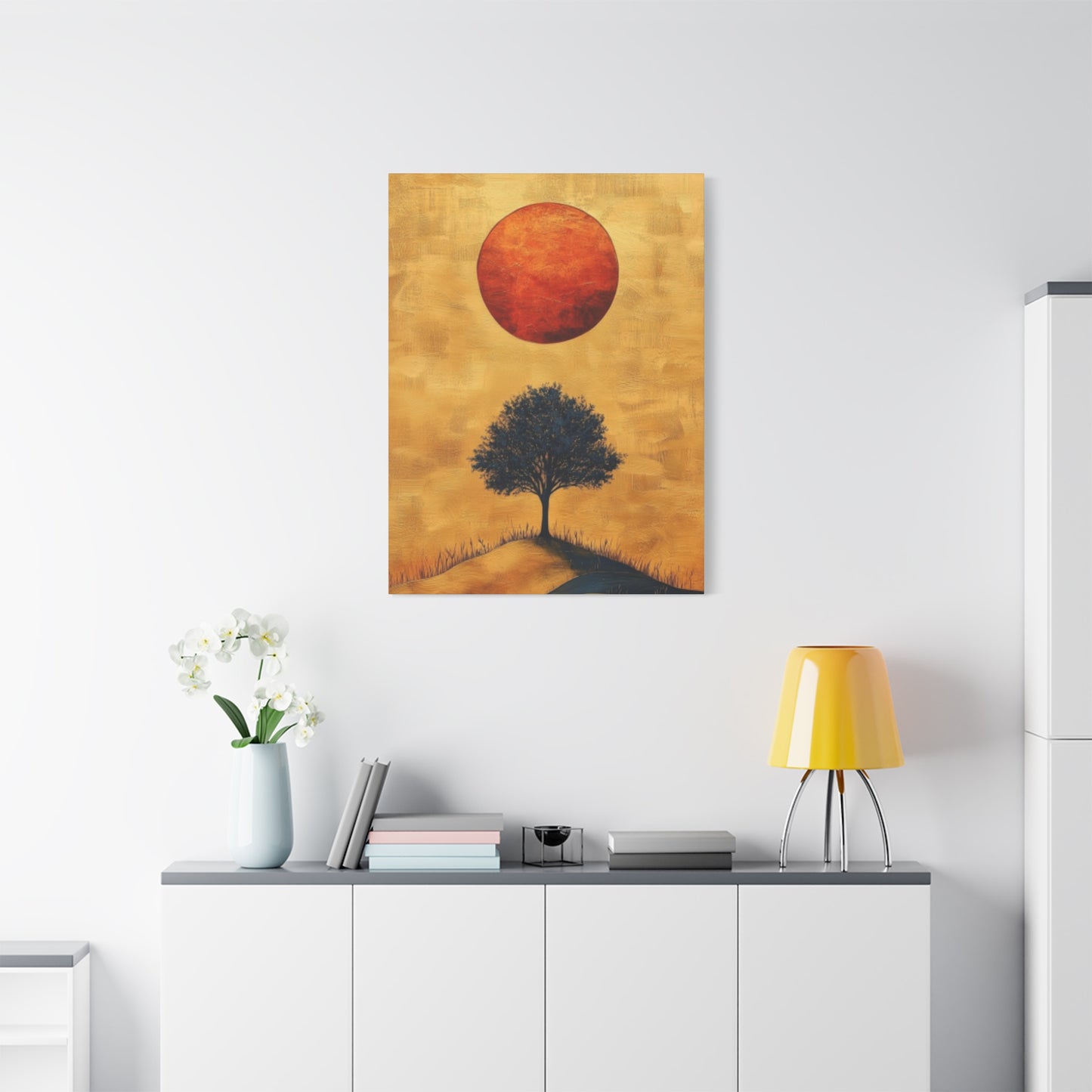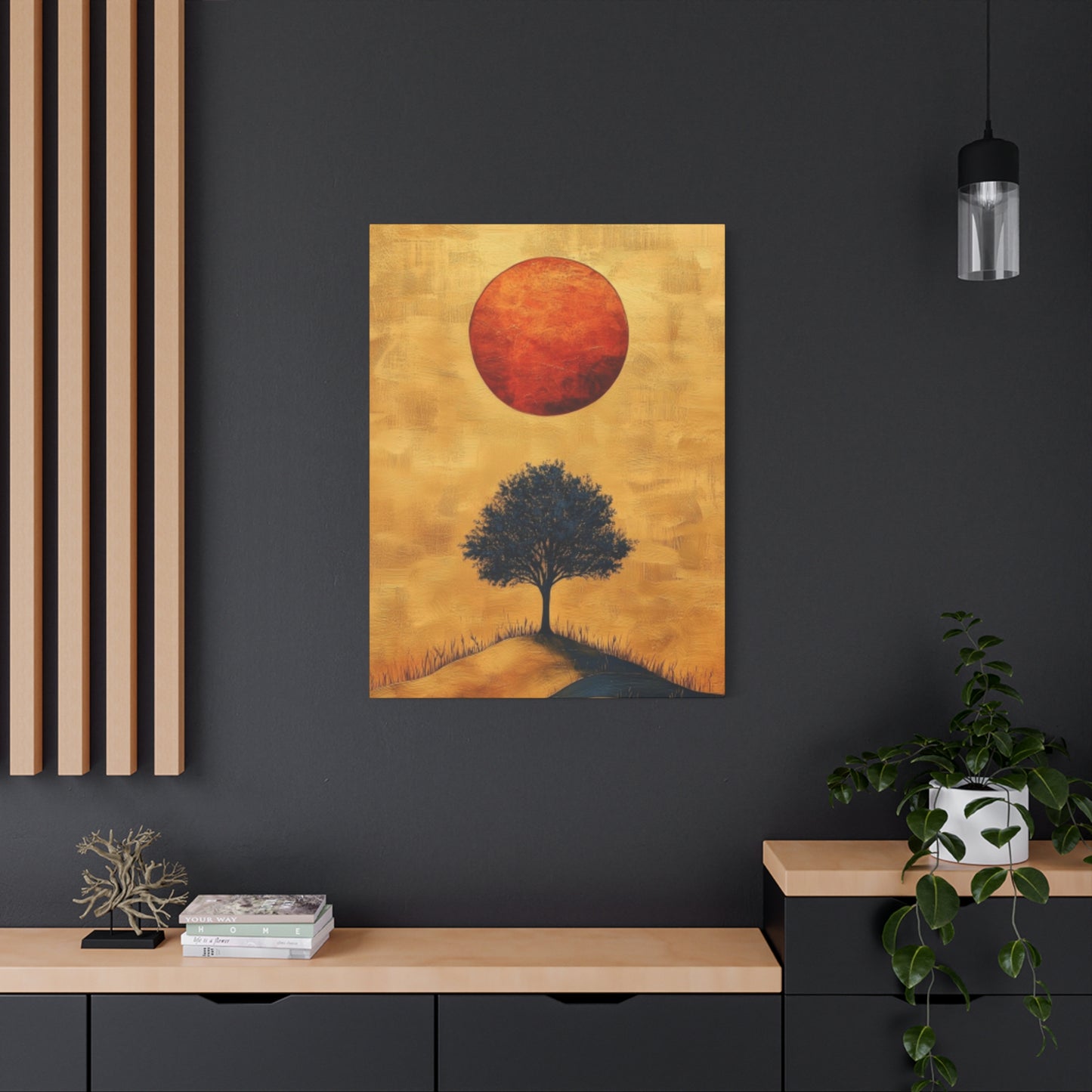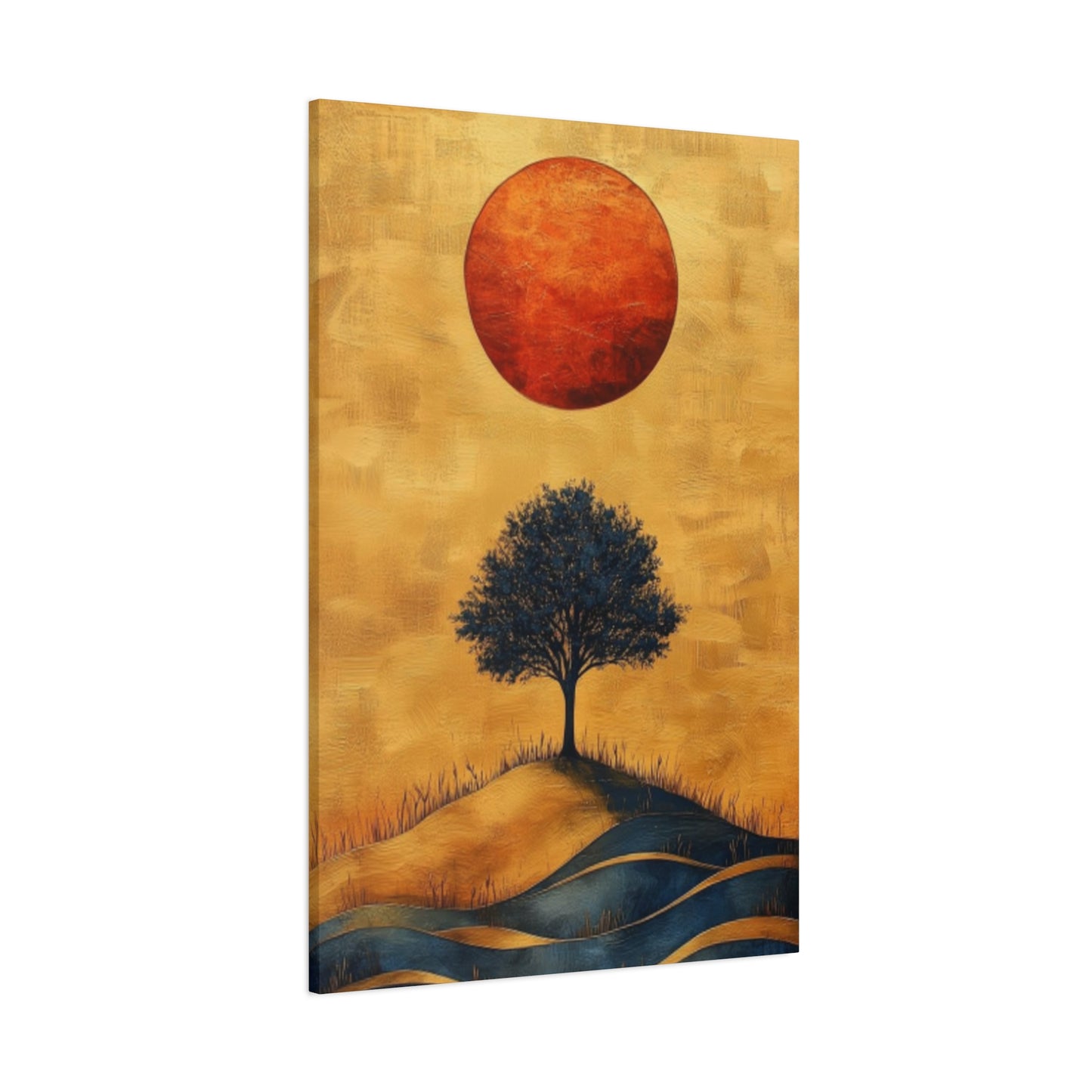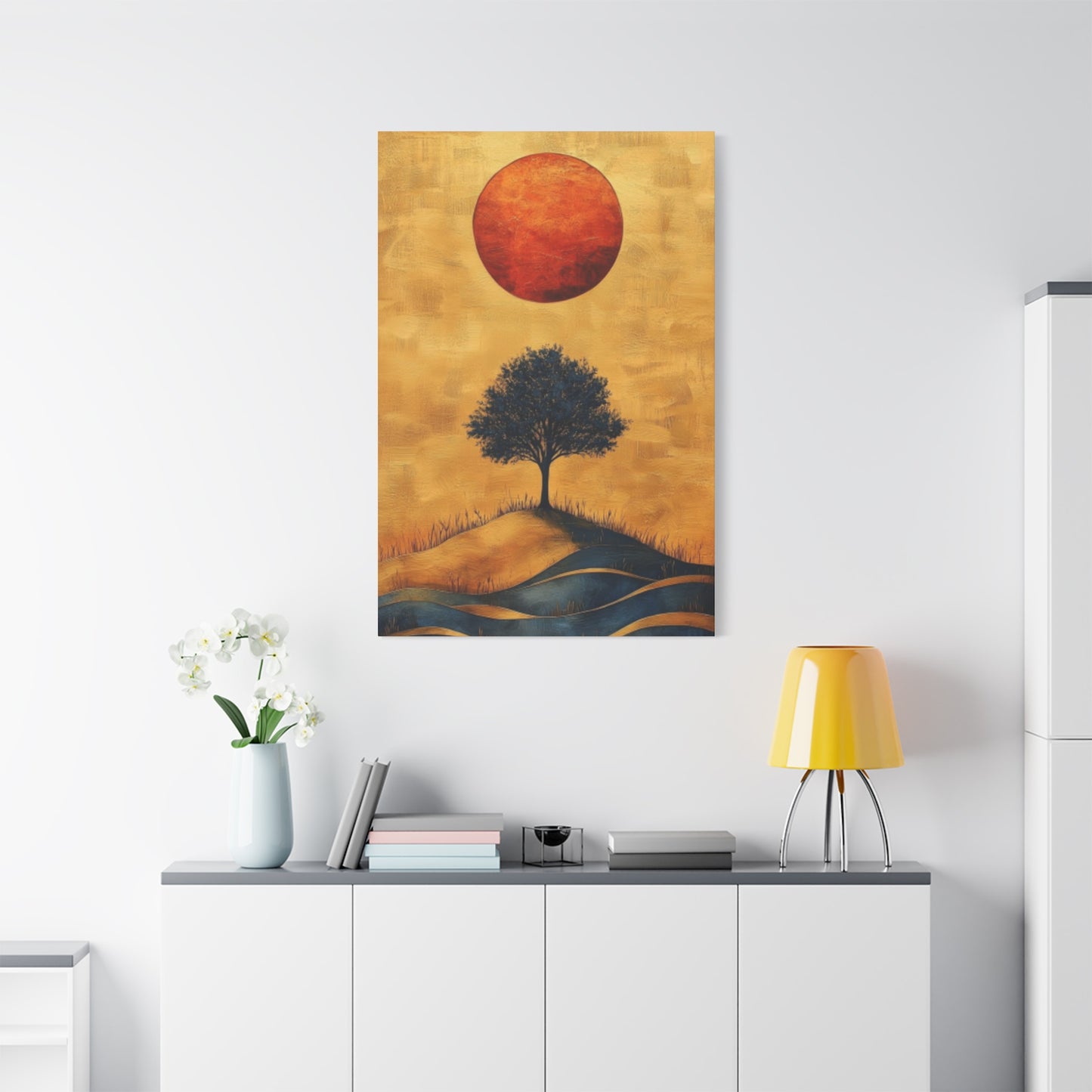Contemporary Sun and Tree Wall Art: A Complete Guide to Modern Natural Motifs
Contemporary geometric representations of solar and botanical elements have revolutionized how we perceive natural motifs in residential and commercial settings. The artistic movement toward angular, structured interpretations of organic forms creates a fascinating tension between the mathematical precision of geometry and the inherent wildness of natural landscapes. Artists working within this genre carefully deconstruct the curved, flowing lines traditionally associated with arboreal and celestial imagery, reassembling them into compositions featuring triangles, circles, hexagons, and other polygonal shapes.
The appeal of geometric sun and tree compositions lies in their ability to communicate complex natural concepts through simplified visual language. When an artist reduces a branching oak to a series of interconnected triangles or transforms radiating sunbeams into precise angular segments, they create an intellectual bridge between human-made order and natural chaos. This stylistic approach resonates particularly well with individuals who appreciate both the beauty of the outdoors and the satisfaction of clean, organized visual elements.
Collectors and enthusiasts of geometric natural motifs often find these pieces integrate seamlessly into contemporary architectural environments. The structured nature of geometric compositions complements modern building materials like steel, glass, and concrete while simultaneously introducing organic subject matter that softens industrial aesthetics. A geometric tree rendered in copper tones against a navy background, for instance, can anchor a living area while maintaining visual cohesion with minimalist furniture and fixtures.
The mathematical foundation of geometric natural artwork also invites viewer participation in a different way than representational pieces. When observing a geometric sun composed of perfect circles radiating outward in calculated intervals, viewers engage both their aesthetic sensibilities and their pattern-recognition capabilities. This dual engagement creates a more intellectually stimulating experience than purely decorative pieces might offer.
Color selection in geometric sun and tree compositions tends toward either bold, saturated hues or carefully curated neutral palettes. Artists might employ vibrant oranges and deep greens to create energetic focal points, or they might work with subtle variations of gray, beige, and white to produce contemplative pieces suitable for tranquil environments. The geometric structure provides a framework that can support either approach without becoming visually overwhelming.
Contemporary printmakers and digital artists have embraced geometric natural motifs with particular enthusiasm, as the precise lines and shapes lend themselves well to reproduction techniques. Limited edition prints featuring geometric interpretations of botanical and solar elements have become increasingly accessible to collectors at various price points, democratizing access to this sophisticated aesthetic movement.
Nature's simplicity in modernism
The modernist philosophical approach to natural subject matter represents a fundamental shift from romantic, detailed depictions toward essential, distilled representations. This movement emerged from a broader cultural desire to strip away unnecessary ornamentation and reveal the core essence of subjects. When applied to botanical and solar imagery, modernist principles encourage artists to identify and emphasize the most fundamental characteristics of their subjects while eliminating superfluous details.
Modernist interpretations of natural scenes operate on the premise that true beauty lies in simplicity and that excessive detail can actually obscure rather than reveal a subject's essential nature. A modernist rendering of a tree might feature a single vertical line representing the trunk with three or four horizontal strokes suggesting branches, yet this economical approach can convey the concept of "treeness" as effectively as a meticulously detailed botanical illustration.
The philosophical underpinnings of modernist simplicity extend beyond mere visual economy. These works invite contemplation about the relationship between representation and reality, asking viewers to consider what minimum information their minds require to recognize and emotionally connect with natural forms. This intellectual dimension adds depth to pieces that might initially appear overly simple or austere.
Modernist natural compositions often employ limited color palettes, sometimes working within two or three carefully selected hues. This restraint forces both artist and viewer to focus on fundamental elements like form, proportion, and spatial relationships rather than being distracted by chromatic variety. A modernist sun might appear as a simple yellow circle on a white background, yet the placement, size, and exact shade of that circle become critically important when other visual elements have been removed.
The influence of modernist simplification on contemporary natural motifs remains profound. Even artists who don't strictly identify as modernists often incorporate reductive techniques when creating pieces intended for current architectural contexts. The clean lines and uncluttered compositions of modernist-influenced work complement contemporary residential and commercial environments where visual calm and coherence are valued.
Collectors drawn to modernist interpretations of natural subjects often appreciate the versatility these pieces offer. Because the compositions avoid specific details that might date them or tie them to particular locations, they maintain relevance across changing decorative trends. A simply rendered tree from 1960 can feel as contemporary today as when it was created, testament to the enduring power of essential forms.
Minimalist sun and tree prints
The minimalist aesthetic movement takes reductive principles to their logical conclusion, creating compositions that contain only the absolute essentials required to communicate their subject. In prints featuring solar and botanical elements, minimalism manifests as dramatic negative space, limited color application, and the most economical possible mark-making. These works challenge viewers to find profound meaning in what initially appears almost absent.
Successful minimalist prints featuring natural elements demonstrate that powerful visual communication doesn't require complexity. A single curved line suggesting a tree branch against an expanse of untouched paper can evoke entire forests in the imagination of an engaged viewer. This approach respects viewer intelligence and invites active participation in completing the artistic experience rather than presenting a fully resolved image that requires only passive observation.
The production of minimalist prints requires extraordinary discipline and confidence from artists. Every mark carries immense weight when so few marks exist. The placement of a small circle representing the sun becomes a critical decision when that circle constitutes one of perhaps only three elements in the entire composition. This heightened significance of each visual choice creates tension and interest that more complex works might achieve through different means.
Minimalist natural prints often explore the relationship between positive and negative space with particular intensity. In many minimalist compositions, the unmarked areas of the paper or canvas become as important as the marked areas, with the emptiness contributing actively to the overall impact. A minimalist tree print might feature a single vertical black line on a white ground, with the surrounding whiteness suggesting sky, atmosphere, and the open environment in which the tree exists.
Color use in minimalist prints typically involves either monochromatic schemes or very limited palettes, often featuring black marks on white grounds or single colors applied sparingly. When color does appear, it carries significant emotional and symbolic weight. A small application of warm orange in an otherwise monochromatic composition can suggest sunset, warmth, and natural cycles with minimal visual information.
The market for minimalist natural prints has expanded considerably as contemporary living environments have embraced simplified aesthetics. These prints complement modern architectural features, uncluttered furnishings, and the general preference for visual calm in residential settings. Their understated presence allows them to coexist harmoniously with other design elements while still providing meaningful points of visual interest.
Color use in modern sun and tree
Contemporary artists working with solar and botanical motifs employ color strategies that diverge significantly from traditional realistic palettes. Rather than limiting themselves to the browns, greens, and yellows that appear in actual natural settings, modern creators embrace unexpected color combinations that evoke emotional responses, create visual impact, and align with current aesthetic preferences.
The liberated approach to color in modern natural compositions allows artists to prioritize mood and atmosphere over literal accuracy. A tree might appear in deep purple or vibrant turquoise, not because real trees display these colors, but because these hues create the psychological effect the artist intends. This freedom from representational constraints opens expansive creative possibilities and allows viewers to experience familiar subjects in refreshingly unfamiliar ways.
Color relationships within modern natural compositions often follow principles derived from color theory rather than natural observation. Complementary color schemes featuring orange suns against blue backgrounds create visual vibration and energy. Analogous schemes using yellow, orange, and red in graduated tones produce harmonious, contemplative effects. Monochromatic approaches exploring variations of a single hue can generate sophisticated, cohesive compositions.
Contemporary color trends significantly influence how artists approach natural subjects. During periods when interior trends favor earth tones and neutral palettes, artists often create natural motifs using sophisticated variations of beige, gray, and taupe. When bolder colors dominate residential aesthetics, vibrant teals, corals, and mustards appear in botanical and solar compositions. This responsiveness to broader color trends helps ensure these pieces integrate successfully into contemporary living environments.
The psychological impact of color choices in natural compositions deserves careful consideration. Warm colors like reds, oranges, and yellows in sun imagery can energize viewers and create feelings of warmth and vitality. Cool blues and greens in tree compositions often produce calming, restorative effects. Artists manipulate these color associations intentionally to create pieces that serve specific emotional purposes within residential or commercial settings.
Digital reproduction technologies have expanded the color possibilities available to contemporary artists working with natural motifs. Unlike historical artists limited to available pigments and dyes, digital creators can access and precisely reproduce millions of distinct colors. This technical capability enables the subtle color gradations and unusual hue combinations that characterize much contemporary work in this genre.
Abstract sun and tree motifs
Abstract approaches to solar and botanical imagery prioritize emotional expression, formal exploration, and conceptual depth over representational accuracy. Artists working abstractly with these natural subjects may retain only the most general references to their source material, creating compositions that suggest rather than depict trees and celestial bodies. This interpretive freedom allows for personal, innovative visual statements that transcend the limitations of literal representation.
The spectrum of abstraction in natural motifs ranges from semi-abstract works that maintain recognizable forms while distorting or stylizing them, to completely non-representational pieces that reference natural subjects only through titles or subtle visual cues. A semi-abstract tree might feature exaggerated proportions, impossible colors, or fragmented forms that clearly derive from botanical sources while departing significantly from realistic depiction. A fully abstract work might present only color relationships, textures, or compositional structures that evoke the essence of natural elements without depicting any identifiable forms.
Abstract natural compositions often explore universal themes and emotions associated with their subjects rather than depicting specific instances. Instead of illustrating a particular oak tree, an abstract artist might attempt to convey the concept of growth, the feeling of rootedness, or the passage of seasons through purely visual means. This conceptual approach engages viewers on intellectual and emotional levels that representational work might not access.
The formal possibilities of abstraction allow artists to experiment with mark-making techniques, material properties, and compositional strategies that representational work might not accommodate. Dripped paint, aggressive brushwork, collaged elements, and mixed media applications can all contribute to abstract natural compositions, with each technique adding layers of visual interest and meaning. A sun might be suggested through radiating gestural marks rather than depicted as a circular form, with the energy of the mark-making itself conveying solar qualities.
Collectors and viewers often develop deeply personal relationships with abstract natural works because the interpretive openness invites individual meaning-making. Without the constraints of literal representation, viewers can project their own experiences, memories, and emotions onto abstract compositions. One person might see a meditation on mortality in an abstract tree composition while another perceives a celebration of resilience, with both interpretations equally valid.
Contemporary abstract natural motifs frequently incorporate influences from various artistic movements including expressionism, color field painting, and gestural abstraction. These historical influences blend with current aesthetic sensibilities to create works that feel both grounded in artistic tradition and relevant to contemporary contexts. The resulting pieces can serve as visual bridges between past and present, connecting viewers to long traditions of artistic exploration while speaking in distinctly modern visual languages.
Light and shadow in modern art
The interplay between illuminated and darkened areas constitutes one of the most powerful tools available to artists working with natural motifs. Contemporary creators manipulate light and shadow relationships to create depth, drama, mood, and visual interest in their compositions. When depicting solar and botanical elements, the treatment of light becomes particularly significant given the inherent relationship between sunlight, photosynthesis, and plant life.
Modern approaches to light and shadow often depart from traditional chiaroscuro techniques that create realistic three-dimensionality through gradual tonal transitions. Instead, contemporary artists might employ flat areas of contrasting value, creating bold graphic effects that emphasize pattern and design over realistic modeling. A modern tree composition might feature stark black silhouettes against light backgrounds, eliminating middle tones entirely to create high-contrast, dramatic impact.
The conceptual use of light and shadow in modern natural compositions can carry symbolic and emotional significance beyond their formal visual functions. Deep shadows might suggest mystery, the unconscious mind, or hidden aspects of nature. Bright, illuminated areas can represent knowledge, growth, or spiritual enlightenment. Artists working consciously with these associations create layered works that operate simultaneously on visual, emotional, and intellectual levels.
Technical innovations in printmaking and digital creation have expanded the ways artists can manipulate light and shadow. Gradient tools in digital applications allow for perfectly smooth tonal transitions impossible to achieve by hand. Printmaking techniques like aquatint enable artists to create rich, velvety shadow areas with distinctive textural qualities. These technical capabilities influence the aesthetic possibilities available to contemporary creators.
Natural lighting conditions themselves often serve as subject matter in modern compositions featuring solar and botanical elements. The quality of dawn light filtering through branches differs fundamentally from harsh midday sun or the warm glow of sunset, and artists capture these distinctions through careful manipulation of color temperature, contrast levels, and compositional strategies. A composition depicting morning light might feature cool tones and soft contrasts, while one suggesting afternoon sun might employ warm colors and strong value contrasts.
The emotional impact of light and shadow relationships in natural compositions can profoundly affect the mood of environments where these works hang. Pieces featuring predominantly light values create airy, optimistic atmospheres, while compositions dominated by darker tones can generate cozy, intimate, or contemplative moods. Understanding these effects allows collectors to select works that will contribute to desired emotional qualities in their living or working environments.
Modernism's take on nature scenes
The modernist artistic movement fundamentally reimagined how artists approached natural subject matter, rejecting romantic idealization and detailed realism in favor of conceptual clarity, formal experimentation, and philosophical inquiry. When modernist principles are applied to scenes featuring solar and botanical elements, the results emphasize essential forms, explore the relationship between representation and abstraction, and investigate the fundamental visual elements that make natural motifs recognizable and emotionally resonant.
Early modernist artists working with natural scenes often sought to reveal the underlying geometric structures they perceived in organic forms. This analytical approach led to compositions that present trees as assemblages of cylinders and cones, or depict the sun as a perfect circle surrounded by radiating triangular rays. This geometric reduction served multiple purposes: it aligned natural subjects with the modern industrial world, challenged viewers to see familiar subjects in new ways, and demonstrated that even seemingly chaotic natural forms followed underlying organizational principles.
The modernist emphasis on flatness and the acknowledgment of the picture plane significantly affected how natural scenes were depicted. Rather than creating illusions of deep three-dimensional space through linear perspective and atmospheric effects, modernist natural compositions often embraced the two-dimensional surface, arranging forms in shallow space or completely flat patterns. This approach honored the physical reality of the painted or printed surface rather than attempting to create windows into imaginary spaces.
Modernist philosophy encouraged artists to explore the essential characteristics that make subjects recognizable and emotionally significant. What minimum information must be present for viewers to perceive a tree? How can the concept of sunlight be conveyed without realistic rendering? These questions drove modernist experimentation and led to increasingly abstract representations that retained emotional and conceptual connections to their natural sources while departing dramatically from realistic depiction.
The modernist movement's influence on contemporary natural motifs remains pervasive even among artists who don't explicitly identify with historical modernism. The freedom to depart from realistic representation, the emphasis on formal qualities like line and color, and the exploration of essential rather than incidental characteristics all derive from modernist innovations. Contemporary pieces featuring simplified natural forms, bold colors, and flat compositions reflect this ongoing influence.
Collectors interested in modernist approaches to natural subjects often appreciate the intellectual rigor and philosophical depth these works offer. Beyond serving decorative functions, modernist-influenced pieces invite contemplation about perception, representation, and the relationship between human consciousness and the natural world. These additional layers of meaning can provide ongoing engagement that purely decorative works might not sustain.
Sun and tree in modern rooms
Contemporary residential and commercial environments provide distinctive contexts for displaying works featuring solar and botanical motifs. The architectural characteristics of modern rooms including open floor plans, large windows, neutral color schemes, and minimalist furnishing approaches create both opportunities and challenges for integrating natural imagery. Understanding how these pieces function within current design contexts enables more successful selection and placement.
The prevalence of open-concept layouts in contemporary architecture affects how artwork is perceived and experienced. In traditional room arrangements, pieces might be viewed primarily from a single seated position, allowing for detailed, contemplative observation. In open layouts, artwork is often viewed from multiple distances and angles as people move through connected living areas. This viewing pattern favors compositions with strong visual impact that read clearly from distance while rewarding closer examination.
Large windows and abundant natural light characterize many contemporary residential settings, creating considerations for artwork placement and selection. Direct sunlight can fade certain pigments over time, making placement opposite windows rather than adjacent to them preferable for valuable pieces. The quality and color temperature of natural light throughout the day also affects how artwork appears, with morning light bringing out cool tones and afternoon light emphasizing warmer colors.
The neutral color palettes common in contemporary settings provide versatile backgrounds for artwork featuring natural motifs. White, gray, and beige walls allow pieces to stand out without competing with surrounding colors, giving collectors freedom to choose works with bold or subtle palettes depending on desired visual impact. The neutrality of contemporary environments also means that artwork often serves as the primary color source in a room, making color selection particularly important.
Minimalist furnishing approaches in modern rooms mean that fewer decorative objects compete for visual attention, potentially increasing the impact of each displayed piece. In environments where a single composition might be the only object on a large wall, that work carries significant responsibility for contributing visual interest and emotional resonance to the environment. This context favors pieces with strong compositional structures and meaningful subject matter.
The integration of technology in contemporary living environments creates new relationships between artwork and surroundings. Large television screens, computer monitors, and smart home interfaces introduce glowing rectangular elements that become visual competitors for static artwork. Pieces featuring natural motifs can provide important counterbalance to these technological elements, introducing organic forms and references to the non-digital world.
Bold lines in sun and tree art
Linear elements constitute one of the most fundamental tools available to artists working with natural motifs. The quality, weight, direction, and character of lines significantly affect the overall impact and emotional tone of compositions. Contemporary artists employ bold, confident linear elements to create graphic impact, define forms, suggest movement, and structure compositions in works featuring solar and botanical subjects.
The aesthetic of bold linearity in natural compositions often derives from various artistic traditions including woodcut printing, graphic design, and illustration. These influences converge in contemporary works that feature thick, decisive marks that read clearly from distance and create strong visual presence. Unlike delicate, subtle lines that require close observation, bold linear elements make immediate impacts and hold attention in visually busy environments.
The expressive potential of varied line qualities allows artists to convey different emotional and conceptual content through their linear choices. Smooth, flowing curves in tree branches can suggest grace and organic growth, while angular, jagged lines might convey energy, chaos, or the harsh geometries imposed on natural forms by human intervention. Artists manipulate these associations intentionally to create specific effects within their compositions.
Bold contour lines that define the edges of forms create clear separations between figure and ground, producing graphic clarity and strong compositional structure. This approach, common in contemporary natural motifs, sacrifices subtle modeling and atmospheric effects in favor of immediate visual impact and design coherence. A tree rendered with a single bold outline against a contrasting background becomes an instantly recognizable silhouette with powerful visual presence.
The relationship between linear elements and color in contemporary natural compositions varies considerably across different artistic approaches. Some artists allow bold lines to contain flat color areas, creating effects similar to stained glass or cloisonné. Others layer transparent colors over linear structures, allowing lines to show through and create visual complexity. Still others work in purely linear terms, allowing the lines themselves to suggest form and space without supplementary color.
Technical considerations influence the appearance of linear elements in contemporary natural motifs. Traditional tools like brushes, pens, and printmaking implements each produce distinctive line qualities that contribute to overall aesthetic character. Digital tools offer different possibilities, enabling perfectly consistent line weights or programmatically varied lines that would be difficult or impossible to achieve by hand. These technical choices become part of the artistic decision-making process.
Texture in sun and tree prints
Surface quality and tactile characteristics add significant dimensionality to works featuring natural motifs, engaging visual perception systems that respond to suggestions of physical texture even in two-dimensional media. Contemporary printmakers and artists employ various techniques to create textural interest in compositions featuring botanical and solar elements, from subtle variations in surface quality to dramatic relief effects.
Traditional printmaking techniques naturally produce textural characteristics that contribute to aesthetic appeal and create connections to artistic heritage. Woodcut prints feature the distinctive grain patterns of carved blocks, with tool marks visible in printed areas. Etching and engraving create precise linear textures with characteristic platemarks at composition edges. Lithographic prints can capture subtle tonal variations and soft, atmospheric qualities. Each technique imparts unique surface characteristics that become integral to the artwork's visual identity.
Contemporary artists working with natural motifs often deliberately emphasize or exaggerate textural elements to create visual interest and evoke associations with natural surfaces. Rough, irregular textures in tree renderings can suggest bark, while smooth, graduated textures in sky areas evoke atmospheric depth. These textural strategies create visual variety within compositions and provide additional information about depicted subjects beyond form and color alone.
Mixed media approaches enable artists to incorporate actual three-dimensional texture into works featuring natural elements. Collaged materials, applied textures, or relief printing techniques create physical surface variations that cast shadows and catch light differently depending on viewing angle and illumination conditions. These dimensional qualities transform static images into dynamic objects that change subtly as viewers move or as lighting conditions vary throughout the day.
Digital printing technologies have introduced new textural possibilities while also enabling faithful reproduction of traditional printmaking textures. High-resolution scanning can capture every detail of an original woodcut or etching, allowing for edition printing that preserves textural characteristics. Simultaneously, digital techniques can create entirely new surface effects impossible to achieve through traditional means, including perfectly regular patterns or mathematically generated organic textures.
The perceptual effects of texture in natural compositions extend beyond purely visual response. Suggested textures can trigger tactile memories and associations, creating more embodied, multisensory experiences of two-dimensional works. Rough textures suggesting tree bark might evoke memories of touching trees, while smooth, soft textures in sky areas could recall the feeling of gentle breezes. These subtle multisensory engagements deepen viewer connections to works featuring natural subjects.
Tree imagery evolution in art
The depiction of botanical forms represents one of the longest continuous traditions in human artistic expression, with tree imagery appearing in prehistoric cave paintings, ancient Egyptian tomb decorations, medieval manuscripts, Renaissance paintings, and contemporary digital creations. Tracing the evolution of how artists have represented these fundamental natural forms reveals changing cultural relationships with nature, developing artistic techniques, and shifting philosophical perspectives on representation itself.
Ancient and medieval tree depictions often carried primarily symbolic rather than representational functions. Trees appeared as stylized symbols of life, knowledge, or spiritual concepts rather than as attempts to capture the visual appearance of actual botanical specimens. The Tree of Life, the Tree of Knowledge, and various sacred trees in different cultural traditions were rendered through conventional formulas that prioritized symbolic legibility over naturalistic accuracy.
The Renaissance interest in observation and realistic representation brought new approaches to botanical imagery. Artists began studying actual trees, documenting their structural characteristics, growth patterns, and species-specific features with increasing accuracy. Leonardo da Vinci's botanical studies exemplify this analytical approach, combining artistic skill with scientific inquiry. This tradition of careful observation continued through subsequent centuries, with botanical illustration developing into a distinct discipline combining artistic and scientific objectives.
Romantic and Impressionist movements brought emotional and atmospheric dimensions to tree imagery. Rather than documenting specimens, artists sought to capture the experience of being among trees, the effects of light filtering through foliage, or the emotional resonance of particular landscapes. These approaches prioritized subjective experience over objective documentation, treating trees as elements within larger compositional and emotional structures.
Modern and contemporary movements dramatically expanded the stylistic range of tree imagery. Expressionist artists used trees as vehicles for emotional projection, rendering them with distorted forms and intense colors that conveyed psychological states. Abstract artists reduced trees to essential forms or completely non-representational elements. Pop artists incorporated tree imagery into commentaries on consumer culture and mass production. Each movement found new meanings and visual possibilities in this ancient subject.
Current trends in tree imagery reflect contemporary concerns including environmental awareness, urbanization, and the human need for nature connection in increasingly built environments. Digital technologies enable new forms of tree representation including algorithmic generation, three-dimensional modeling, and hybrid approaches combining photography with illustration. Despite these innovations, the fundamental human impulse to depict and contemplate trees continues undiminished from its prehistoric origins.
Sun symbolism in modernism
Solar imagery has carried profound symbolic weight across human cultures and throughout artistic history, representing divinity, life force, consciousness, and temporal cycles. When modernist artists engaged with sun symbolism, they often retained these deep associations while transforming the visual vocabulary through which solar concepts were expressed. The result was a body of work that maintained connections to ancient symbolic traditions while speaking in distinctly contemporary visual languages.
The modernist tendency toward reduction and simplification found natural application in solar imagery. The sun's simple circular form and radiating structure lent itself to geometric abstraction and essential representation. Modernist artists could evoke solar power and symbolism through minimal means, perhaps a simple circle or radiating lines, trusting viewers to bring their cultural knowledge of sun symbolism to complete the artistic communication.
Different modernist movements interpreted sun symbolism through their particular philosophical lenses. Constructivist artists might treat the sun as an emblem of rational order and industrial progress, rendering it through precise geometric forms. Expressionist artists used solar imagery to convey emotional intensity and psychological states, with distorted or dramatically colored suns suggesting internal experiences rather than external observations. Surrealist artists incorporated suns into dream-like scenarios that revealed subconscious associations and unexpected juxtapositions.
The relationship between sun symbolism and concepts of enlightenment, consciousness, and knowledge appeared frequently in modernist work. The sun's light-giving properties made it a natural metaphor for intellectual illumination and spiritual awakening, themes that resonated with modernism's optimistic belief in human progress and the power of reason. Solar imagery in modernist works often carried these associations, functioning as visual shorthand for humanity's aspirational impulses.
Color choices in modernist solar imagery often departed from naturalistic yellows and oranges, with artists employing unexpected colors to create specific effects or challenge conventional associations. A blue or green sun might disrupt viewer expectations, forcing fresh consideration of familiar symbols. These color manipulations demonstrate modernism's willingness to prioritize conceptual or aesthetic concerns over representational accuracy.
Contemporary artists working with solar symbolism continue drawing on modernist innovations while incorporating current concerns and technologies. Solar imagery might now reference solar power and sustainable energy, connecting ancient sun worship to contemporary environmental consciousness. Digital creation tools enable new formal approaches to solar representation while ancient symbolic associations persist, creating productive tensions between tradition and innovation.
Modern nature scene transformations
The process of transforming observed or imagined natural scenes into finished artistic works involves numerous decisions about composition, emphasis, elimination, and interpretation. Contemporary artists working with scenes featuring botanical and solar elements make these transformative choices within frameworks influenced by modernist principles, current aesthetic preferences, technological capabilities, and personal artistic visions. Understanding these transformation processes illuminates how contemporary natural imagery relates to both artistic traditions and actual natural environments.
The initial stage of transforming natural scenes often involves selection and framing decisions. Artists choose which elements of complex natural environments to include, what viewpoints to adopt, and how to arrange chosen elements within compositional boundaries. A forest scene might be reduced to a single tree silhouette, or an expansive landscape condensed to essential forms of ground, tree, and sun. These reductive choices prioritize visual impact and conceptual clarity over comprehensive documentation.
Contemporary transformation approaches frequently involve stylistic filtering that converts observed details into consistent visual languages. A photograph of an actual tree might undergo translation into bold contour lines, geometric shapes, or abstract marks that suggest rather than depict the source material. This stylistic consistency creates visual coherence while allowing artists to impose personal aesthetics onto natural subjects.
Color transformation represents another significant dimension of contemporary approaches to natural scenes. Artists routinely depart from observed colors, substituting unexpected or intensified hues that serve compositional, emotional, or conceptual purposes. An actual brown tree trunk might become vibrant red in the finished work, not through error or ignorance but through deliberate choice aimed at achieving specific effects.
Scale and proportion manipulations allow artists to emphasize certain elements or create desired compositional relationships. A sun might be enlarged to dominate compositions, or trees reduced to minimal marks that register as distant elements. These proportional adjustments prioritize designed visual relationships over naturalistic spatial accuracy, creating compositions that work as balanced, intentional arrangements rather than windows onto actual spaces.
Contemporary digital tools have introduced new transformation possibilities including filters, distortions, and hybrid approaches combining multiple source images or mixing photographic and illustrative elements. These technical capabilities enable transformations that would be difficult or impossible through traditional means, expanding the range of relationships between source materials and finished works. Despite these technical innovations, the fundamental artistic challenge of transforming observations into meaningful visual statements remains constant across historical periods and technical approaches.
Gallery walls with sun and tree art
The contemporary practice of creating gallery wall arrangements featuring multiple related pieces offers distinctive opportunities for displaying works with natural motifs. Rather than hanging single large pieces in isolation, gallery wall approaches allow collectors to build visual narratives, explore variations on themes, mix different sizes and formats, and create substantial visual impact through accumulated smaller elements. Understanding effective gallery wall strategies enables successful display of works featuring solar and botanical subjects.
The most successful gallery wall arrangements balance unity and variety, creating overall coherence while maintaining visual interest through differences among individual pieces. In collections featuring natural motifs, unity might derive from consistent subject matter, limited color palettes, or similar stylistic approaches across pieces. Variety emerges through different compositions, scale variations, or subtle differences in treatment within overall stylistic consistency.
Planning gallery wall layouts requires attention to spatial relationships among pieces, including intervals between frames, overall arrangement shapes, and relationships to architectural features like windows and doorways. Symmetrical grid arrangements create formal, ordered impressions suitable for traditional settings, while organic, asymmetrical clusters generate more casual, contemporary feelings. The arrangement structure itself becomes an expressive element contributing to overall effect.
Color relationships across multiple pieces significantly affect gallery wall success. Collections might maintain strict monochromatic schemes for maximum coherence, or deliberately incorporate color variations that create visual movement across the arrangement. In natural motif collections, color can suggest seasonal progressions, times of day, or conceptual relationships among pieces that enhance viewer engagement and interpretive possibilities.
Scale variations within gallery walls create visual hierarchy and prevent monotonous uniformity. Combining larger anchor pieces with smaller supporting works allows for compositional structure that guides viewer attention and creates rhythmic variation. In natural motif collections, larger pieces might feature more complex compositions while smaller works explore specific details or simplified elements, creating relationships between comprehensive and focused perspectives.
The relationship between gallery wall arrangements and room functions deserves consideration during planning. Active social areas might benefit from energetic, colorful arrangements that stimulate conversation, while private spaces could feature calmer, more contemplative collections. Natural motifs offer particular flexibility for different functional contexts, as their universal subject matter resonates across various room types and purposes.
Emotional effects of sun and tree art
Works featuring natural motifs generate emotional responses through multiple mechanisms including color psychology, compositional structure, symbolic associations, and personal memories triggered by subject matter. Understanding how these emotional effects operate enables both artists creating such works and collectors selecting them to make informed decisions aligned with desired psychological impacts in particular environments.
The psychological effects of color in natural compositions derive partly from biological responses and partly from cultural associations. Warm colors including reds, oranges, and yellows in sun imagery typically generate feelings of energy, warmth, and vitality because these hues associate with fire, sunlight, and activation. Cool colors like blues and greens in tree compositions often produce calming, restorative effects related to associations with water, shade, and natural tranquility. Artists manipulate these color psychology principles deliberately to create specific emotional tones.
Compositional factors including balance, movement, and emphasis affect emotional responses to natural imagery. Symmetrical, balanced compositions tend to generate feelings of stability, order, and calm, while asymmetrical or dynamic arrangements might produce tension, energy, or interest. In natural compositions, the relationship between stable elements like tree trunks and dynamic elements like branches or radiating sun rays creates emotional tone through visual movement and rest.
Symbolic and archetypal associations with natural subjects operate at deep psychological levels, connecting individual viewers to collective cultural meanings. Trees symbolize growth, rootedness, life cycles, and connection between earth and sky across many cultural traditions. Solar imagery carries associations with consciousness, vitality, temporal cycles, and life force. These deep symbolic resonances mean that works featuring these subjects can evoke profound emotional responses even through simple visual means.
Personal memories and experiences related to natural environments strongly influence emotional responses to imagery featuring natural subjects. Someone with positive childhood memories of climbing trees might experience joy and nostalgia when viewing tree imagery, while someone who finds sunsets particularly moving might respond strongly to solar compositions. These individual associations make emotional responses to natural imagery highly personal while still operating within frameworks of shared cultural meanings.
The context in which natural imagery is experienced affects emotional impact significantly. A vibrant, energetic composition might feel invigorating in a home office but overwhelming in a bedroom intended for rest. Understanding these contextual emotional effects enables appropriate placement decisions that align artwork emotional qualities with room functions and desired psychological atmospheres.
Contemporary psychological research increasingly validates the beneficial emotional effects of nature imagery in built environments. Studies demonstrate that even photographic or illustrated natural subjects can reduce stress, improve mood, and enhance well-being, particularly in settings where access to actual nature is limited. These findings suggest practical value beyond aesthetic pleasure in incorporating natural motifs into residential and commercial settings.
Eco-themes in sun and tree art
Contemporary environmental awareness has significantly influenced how artists approach natural subject matter, with many creators using solar and botanical imagery to explore ecological themes, express environmental concerns, or advocate for conservation and sustainability. This thematic dimension adds conceptual depth to works that might otherwise function purely aesthetically, creating opportunities for meaningful engagement with urgent contemporary issues through visual means.
Climate change themes appear in contemporary natural imagery through various strategies including depicting environmental degradation, celebrating natural resilience, or exploring relationships between human activity and natural systems. An artist might render trees with fragmented or damaged forms suggesting deforestation or environmental stress, or create compositions celebrating the persistence of natural life despite human pressures. These thematic approaches transform natural imagery from decorative subject matter into vehicles for environmental commentary.
Solar imagery takes on particular significance in the context of renewable energy and sustainable living movements. Contemporary works featuring sun motifs might reference solar power potential, sustainable energy futures, or humanity's relationship with this fundamental energy source. These associations add contemporary relevance to ancient solar symbolism, connecting traditional artistic subjects to urgent current concerns.
The aesthetic treatment of eco-themed works varies considerably, from realistic documentation of environmental conditions to abstract explorations of ecological concepts. Some artists work in reportorial modes, creating images that function almost as visual journalism about environmental issues. Others employ abstraction, metaphor, or symbolic approaches that invite interpretive engagement with ecological themes rather than presenting explicit documentary evidence.
Collectors and viewers increasingly value art that engages meaningfully with environmental concerns, seeing aesthetic objects as potential vehicles for consciousness-raising and values expression. Displaying works that address ecological themes allows individuals to signal environmental commitments while simultaneously enjoying aesthetic pleasure. This dual function makes eco-themed natural imagery particularly appealing to environmentally conscious collectors.
Conclusion
Contemporary sun and tree wall art beautifully blends the timeless elements of nature with modern artistic expression, making it a perfect addition to any home seeking a fresh yet grounded aesthetic. These natural motifs—sun and tree—carry deep symbolic meaning and evoke a sense of life, growth, warmth, and renewal. By incorporating contemporary interpretations of these themes into your décor, you not only elevate the visual appeal of your space but also invite a connection to the natural world that inspires balance, positivity, and serenity.
The sun and tree are universal symbols that resonate across cultures and time. The sun, with its radiant energy, symbolizes vitality, hope, and illumination. It represents new beginnings and the power to overcome darkness. Trees, on the other hand, symbolize growth, strength, stability, and the cycles of life. When these motifs are reimagined through contemporary art styles—whether abstract, minimalist, geometric, or mixed media—they take on a fresh vibrancy that complements modern living spaces beautifully. This fusion of age-old symbolism with cutting-edge design creates pieces that are both meaningful and visually captivating.
Contemporary sun and tree wall art offers incredible versatility in terms of style, medium, and scale. From sleek metal sculptures and bold canvas prints to subtle watercolor paintings and textured mixed-media pieces, there is an option to suit virtually every taste and décor theme. Whether your interior leans toward minimalist chic, eclectic boho, or urban modern, these artworks can be seamlessly integrated to create a harmonious and inviting environment. Their natural themes bring warmth and life to neutral color palettes, while their contemporary designs add an element of sophistication and creativity.
Moreover, incorporating sun and tree motifs into your décor can foster a deeper emotional and psychological connection to nature—something especially valuable in urban settings where access to green spaces might be limited. These artworks act as visual anchors that encourage mindfulness, reflection, and a sense of groundedness. They remind us of our roots and the energy that sustains life, promoting feelings of calm, rejuvenation, and hope. Such qualities make contemporary sun and tree wall art not just decorative elements, but meaningful parts of a wellness-focused living space.
In addition to personal enjoyment, contemporary sun and tree wall art can also serve as thoughtful gifts. Their universal symbolism and modern aesthetic appeal to a wide range of recipients and occasions—whether housewarmings, birthdays, or milestones. Gifting such art expresses good wishes for growth, light, and positivity, making it a meaningful and lasting present.
In conclusion, contemporary sun and tree wall art offers a compelling blend of natural symbolism and modern design that can elevate any living space. By bringing these motifs into your home, you create an environment that celebrates life, growth, and renewal while embracing contemporary artistic trends. Whether you choose bold and abstract pieces or subtle and minimalist designs, sun and tree wall art provides a timeless yet fresh way to connect with nature and enhance your décor. Embrace the energy and tranquility these natural motifs bring, and let your walls tell a story of harmony, strength, and illumination.

















